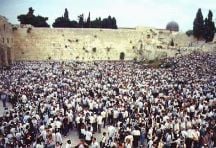Jerusalem, Judaism’s holiest city, is mentioned hundreds of times in the Hebrew Bible. It was the capital city of ancient Jewish kingdoms and home to Judaism’s holiest Temple (Beit HaMikdash). Jews from all over the ancient world would make pilgrimages to the Beit HaMikdash three times a year to participate in worship and festivities, as commanded in the Torah. Jerusalem and the Beit HaMikdash have remained the focus of Jewish longing, aspiration, and prayers. Daily prayers (said while facing Jerusalem and the Temple Mount) and grace after meals include multiple supplications for the restoration of Jerusalem and the Beit HaMikdash. Jews still maintain the 9th day of the Hebrew month of Av, the date on which both the First and Second Temples were destroyed, as a day of mourning. The Jewish wedding ceremony concludes with the chanting of the biblical phrase, “If I forget thee, O Jerusalem, let my right hand forget its cunning,” and the breaking of a glass by the groom to commemorate the destruction of the Temples. And the conclusion of the Yom Kippur services and the Passover Seder conclude each year with the phrase “Next Year in Jerusalem.”

Model of Second Jewish Temple
The Temple Mount is the holiest site in Judaism. The Temple was built, according to Jewish tradition, on the Even Hashtiya, the foundation stone upon which the world was created. This is considered the epicenter of Judaism, where the Divine Presence (Shechina) rests, where the biblical Isaac was brought for sacrifice, where the Holy of Holies and Ark of the Covenant housing the Ten Commandments once stood, and where the Temple was again rebuilt in 515 BCE before being destroyed by the Romans in 70 CE. The Temple Mount is also known as Mount Moriah (Har HaMoriah), mentioned frequently in the Bible.
The Western Wall (Kotel Hama’aravi, known simply as the Wall or Kotel) is the remnant of the outer retaining wall built by Herod to level the ground and expand the area housing the Second Jewish Temple. Its holiness derives from its proximity to the Temple site and specifically its proximity to the Western Wall of the Temple’s Holy of Holies (Kodesh Hakodashim—the inner sanctuary that housed the Ark of the Covenant–the Aron HaBrit–and where the High Priest–Kohen Gadol–alone was permitted to enter on Yom Kippur). According to Midrashic sources, the Divine Presence never departed from the Western wall of the Temple’s Holy of Holies. For the last several hundred years, Jews have prayed at Herod’s Western Wall because it was the closest accessible place to Judaism’s holiest site.

Jewish Worshippers at Western Wall

